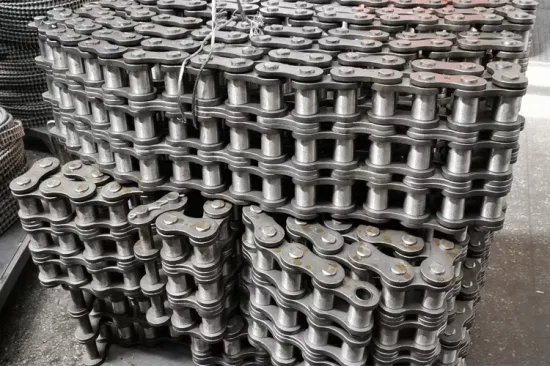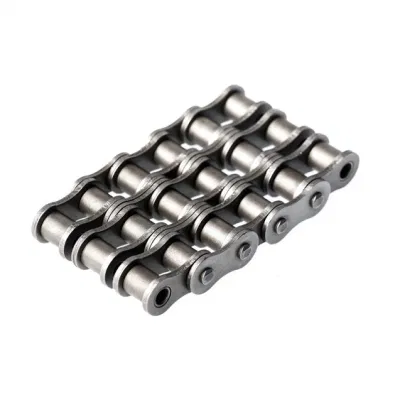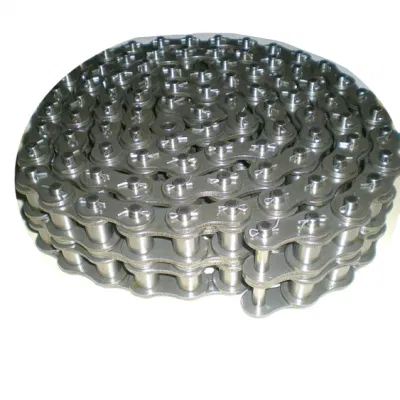Product Description
| Chain No. | Pitch
P |
Roller diameter
d1max |
Width between inner plates b1min mm |
Pin diameter
d2max |
Pin length | Inner plate depth
h2 max |
Plate thickness
t/Tmax |
Breaking load
Q |
Weight per meter q kg/m |
|
| Lmax mm |
Lcmax mm |
|||||||||
| #06BSS-1 | 9.525 | 6.35 | 5.72 | 3.28 | 13.15 | 14.10 | 8.20 | 1.30 | 6.2/1409 | 0.41 |
*Bush chain:d1 in the table indicates the external diameter of the bush
*Straight side plates
Stainless steel chains are suitable for corrosive conditions involving food,chemicals pharmaceuticals,etc.and also suitable for high and low temperature conditions.
Chain Pictures
Roller chain
Roller chain or bush roller chain is the type of chain drive most commonly used for transmission of mechanical power on many kinds of domestic, industrial and agricultural machinery, including conveyors, wire- and tube-drawing machines, printing presses, cars, motorcycles, and bicycles. It consists of a series of short cylindrical rollers held together by side links. It is driven by a toothed wheel called a sprocket. It is a simple, reliable, and efficient[1] means of power transmission.
Though CHINAMFG Renold is credited with inventing the roller chain in 1880, sketches by Leonardo da Vinci in the 16th century show a chain with a roller bearing.
Construction of the chain
Two different sizes of roller chain, showing construction.
There are 2 types of links alternating in the bush roller chain. The first type is inner links, having 2 inner plates held together by 2 sleeves or bushings CHINAMFG which rotate 2 rollers. Inner links alternate with the second type, the outer links, consisting of 2 outer plates held together by pins passing through the bushings of the inner links. The “bushingless” roller chain is similar in operation though not in construction; instead of separate bushings or sleeves holding the inner plates together, the plate has a tube stamped into it protruding from the hole which serves the same purpose. This has the advantage of removing 1 step in assembly of the chain.
The roller chain design reduces friction compared to simpler designs, resulting in higher efficiency and less wear. The original power transmission chain varieties lacked rollers and bushings, with both the inner and outer plates held by pins which directly contacted the sprocket teeth; however this configuration exhibited extremely rapid wear of both the sprocket teeth, and the plates where they pivoted on the pins. This problem was partially solved by the development of bushed chains, with the pins holding the outer plates passing through bushings or sleeves connecting the inner plates. This distributed the wear over a greater area; however the teeth of the sprockets still wore more rapidly than is desirable, from the sliding friction against the bushings. The addition of rollers surrounding the bushing sleeves of the chain and provided rolling contact with the teeth of the sprockets resulting in excellent resistance to wear of both sprockets and chain as well. There is even very low friction, as long as the chain is sufficiently lubricated. Continuous, clean, lubrication of roller chains is of primary importance for efficient operation as well as correct tensioning.
Lubrication
Many driving chains (for example, in factory equipment, or driving a camshaft inside an internal combustion engine) operate in clean environments, and thus the wearing surfaces (that is, the pins and bushings) are safe from precipitation and airborne grit, many even in a sealed environment such as an oil bath. Some roller chains are designed to have o-rings built into the space between the outside link plate and the inside roller link plates. Chain manufacturers began to include this feature in 1971 after the application was invented by Joseph Montano while working for Whitney Chain of Hartford, Connecticut. O-rings were included as a way to improve lubrication to the links of power transmission chains, a service that is vitally important to extending their working life. These rubber fixtures form a barrier that holds factory applied lubricating grease inside the pin and bushing wear areas. Further, the rubber o-rings prevent dirt and other contaminants from entering inside the chain linkages, where such particles would otherwise cause significant wear.[citation needed]
There are also many chains that have to operate in dirty conditions, and for size or operational reasons cannot be sealed. Examples include chains on farm equipment, bicycles, and chain saws. These chains will necessarily have relatively high rates of wear, particularly when the operators are prepared to accept more friction, less efficiency, more noise and more frequent replacement as they neglect lubrication and adjustment.
Many oil-based lubricants attract dirt and other particles, eventually forming an CHINAMFG paste that will compound wear on chains. This problem can be circumvented by use of a “dry” PTFE spray, which forms a solid film after application and repels both particles and moisture.
Motorcycle chain lubrication
Chains operating at high speeds comparable to those on motorcycles should be used in conjunction with an oil bath. For modern motorcycles this is not possible, and most motorcycle chains run unprotected. Thus, motorcycle chains tend to wear very quickly relative to other applications. They are subject to extreme forces and are exposed to rain, dirt, sand and road salt.
Motorcycle chains are part of the drive train to transmit the motor power to the back wheel. Properly lubricated chains can reach an efficiency of 98% or greater in the transmission. Unlubricated chains will significantly decrease performance and increase chain and sprocket wear.
Two types of CHINAMFG lubricants are available for motorcycle chains: spray on lubricants and oil drip feed systems.
Spray lubricants may contain wax or PTFE. While these lubricants use tack additives to stay on the chain they can also attract dirt and sand from the road and over time produce a grinding paste that accelerates component wear.
Oil drip feed systems continuously lubricate the chain and use light oil that does not stick to the chain. Research has shown that oil drip feed systems provide the greatest wear protection and greatest power saving.
Variants in design
Layout of a roller chain: 1. Outer plate, 2. Inner plate, 3. Pin, 4. Bushing, 5. Roller
If the chain is not being used for a high wear application (for instance if it is just transmitting motion from a hand-operated lever to a control shaft on a machine, or a sliding door on an oven), then 1 of the simpler types of chain may still be used. Conversely, where extra strength but the smooth drive of a smaller pitch is required, the chain may be “siamesed”; instead of just 2 rows of plates on the outer sides of the chain, there may be 3 (“duplex”), 4 (“triplex”), or more rows of plates running parallel, with bushings and rollers between each adjacent pair, and the same number of rows of teeth running in parallel on the sprockets to match. Timing chains on automotive engines, for example, typically have multiple rows of plates called strands.
Roller chain is made in several sizes, the most common American National Standards Institute (ANSI) standards being 40, 50, 60, and 80. The first digit(s) indicate the pitch of the chain in eighths of an inch, with the last digit being 0 for standard chain, 1 for lightweight chain, and 5 for bushed chain with no rollers. Thus, a chain with half-inch pitch would be a #40 while a #160 sprocket would have teeth spaced 2 inches apart, etc. Metric pitches are expressed in sixteenths of an inch; thus a metric #8 chain (08B-1) would be equivalent to an ANSI #40. Most roller chain is made from plain carbon or alloy steel, but stainless steel is used in food processing machinery or other places where lubrication is a problem, and nylon or brass are occasionally seen for the same reason.
Roller chain is ordinarily hooked up using a master link (also known as a connecting link), which typically has 1 pin held by a horseshoe clip rather than friction fit, allowing it to be inserted or removed with simple tools. Chain with a removable link or pin is also known as cottered chain, which allows the length of the chain to be adjusted. Half links (also known as offsets) are available and are used to increase the length of the chain by a single roller. Riveted roller chain has the master link (also known as a connecting link) “riveted” or mashed on the ends. These pins are made to be durable and are not removable.
Use
An example of 2 ‘ghost’ sprockets tensioning a triplex roller chain system
Roller chains are used in low- to mid-speed drives at around 6-0-0. p. 211. Retrieved 17 May 2-0-0. p. 86. Retrieved 30 January 2015.
Green 1996, pp. 2337-2361
“ANSI G7 Standard Roller Chain – Tsubaki Europe”. Tsubaki Europe. Tsubakimoto Europe B.V. Retrieved 18 June 2.
External links
Wikimedia Commons has media related to Roller chains.
The Complete Xihu (West Lake) Dis. to Chain
Categories: Chain drivesMechanical power transmissionMechanical power control
Products Package
Why Choose Us
1. Reliable Quality Assurance System
2. Cutting-Edge Computer-Controlled CNC Machines
3. Bespoke Solutions from Highly Experienced Specialists
4. Customization and OEM Available for Specific Application
5. Extensive Inventory of Spare Parts and Accessories
6. Well-Developed CHINAMFG Marketing Network
7. Efficient After-Sale Service System
| Standard or Nonstandard: | Standard |
|---|---|
| Application: | Textile Machinery, Garment Machinery, Conveyer Equipment, Packaging Machinery, Electric Cars, Motorcycle, Food Machinery, Marine, Mining Equipment, Agricultural Machinery, Car |
| Surface Treatment: | Polishing |
| Structure: | Roller Chain |
| Material: | Stainless Steel |
| Type: | Bush Chain |
| Samples: |
US$ 0/Meter
1 Meter(Min.Order) | |
|---|
| Customization: |
Available
| Customized Request |
|---|

Can a bush chain be used in continuous operation applications?
Yes, a bush chain can be used in continuous operation applications. Continuous operation refers to a scenario where the chain is constantly in motion without significant periods of rest.
Bush chains are designed to handle continuous operation and are commonly used in various industrial applications that require continuous power transmission or material handling. They are known for their durability, reliability, and ability to withstand prolonged use.
When selecting a bush chain for continuous operation, it is important to consider factors such as the chain’s load capacity, speed rating, lubrication requirements, and overall durability. It’s crucial to choose a chain that is specifically designed for continuous operation to ensure optimal performance and longevity.
Regular maintenance, including proper lubrication and periodic inspections, is essential to ensure the smooth operation and longevity of the bush chain in continuous applications. Following the manufacturer’s guidelines for maintenance and lubrication intervals is crucial to prevent premature wear and ensure reliable operation.
Overall, bush chains are well-suited for continuous operation applications and provide a reliable means of power transmission or material handling in various industries.

How do you troubleshoot common issues with bush chains?
Troubleshooting common issues with bush chains involves identifying the problem and taking appropriate corrective actions. Here are some common issues and their troubleshooting steps:
1. Chain Misalignment: If the bush chain is misaligned, it can cause excessive wear, noise, and premature failure. To troubleshoot this issue, check the alignment of the sprockets and adjust them as necessary. Ensure that the chain runs smoothly and evenly on the sprockets without any binding or skipping.
2. Chain Binding: If the chain becomes stuck or binds during operation, it may be due to improper lubrication, debris accumulation, or worn-out components. Start by cleaning the chain and sprockets to remove any debris or contaminants. Lubricate the chain with the recommended lubricant to reduce friction. If the issue persists, inspect the chain for signs of wear and replace any worn-out components.
3. Excessive Chain Wear: Excessive chain wear can lead to elongation, reduced performance, and increased risk of failure. To troubleshoot this issue, measure the chain’s length and compare it to the manufacturer’s specifications. If the chain has elongated beyond the acceptable limits, it needs to be replaced. Additionally, inspect the chain for signs of pin and bushing wear, plate wear, or sprocket wear. Replace any worn components as necessary.
4. Insufficient Lubrication: Inadequate lubrication can result in increased friction, wear, and premature failure of the bush chain. If the chain appears dry or there are signs of insufficient lubrication, apply the appropriate lubricant to the chain according to the manufacturer’s recommendations. Ensure that the lubricant reaches all the critical components of the chain, including the pins, bushings, and rollers.
5. Chain Breakage: Chain breakage can occur due to excessive loads, sudden impacts, or worn-out components. To troubleshoot this issue, inspect the chain for any signs of damaged or broken links. Identify the cause of the breakage, such as overload or impact, and address it accordingly. Replace the broken chain links with a new chain segment and ensure proper installation.
6. Excessive Noise and Vibration: Unusual noise and vibration during chain operation can indicate underlying issues. Inspect the chain for signs of misalignment, worn-out components, or inadequate tension. Address the specific cause by adjusting the alignment, replacing worn parts, or adjusting the tension to reduce noise and vibration.
It’s important to consult the manufacturer’s guidelines and recommendations for troubleshooting specific issues with bush chains. Regular inspection, proper lubrication, and timely maintenance can help prevent common issues and ensure the reliable and efficient operation of the bush chain.

What are the different types of bush chains available?
There are several types of bush chains available, each designed to meet specific application requirements. Here are some common types:
1. Standard Bush Chains: These chains have a simple construction with bushings and rollers. They are commonly used in general industrial applications that require moderate load capacity and speed.
2. Heavy-Duty Bush Chains: These chains are designed for applications that involve high loads, such as heavy machinery or equipment. They have a robust construction with thicker plates and larger diameter bushings to withstand the increased demands.
3. Extended Pitch Bush Chains: These chains have a larger pitch than standard chains, providing more space between each link. They are often used in applications that require conveying large or irregularly shaped objects, such as in material handling or packaging industries.
4. Double-Pitch Bush Chains: These chains have double the pitch of standard chains, allowing for longer spans between sprockets. They are commonly used in applications that require longer conveying distances or lower-speed operation.
5. Stainless Steel Bush Chains: These chains are made from stainless steel material, offering excellent corrosion resistance. They are suitable for applications in corrosive environments or industries with strict hygiene requirements, such as food processing or pharmaceutical manufacturing.
6. Self-Lubricating Bush Chains: These chains incorporate special materials or coatings that provide self-lubrication properties. They eliminate the need for external lubrication and reduce maintenance requirements. Self-lubricating bush chains are ideal for applications where regular lubrication is challenging or impractical.
7. Specialty Bush Chains: There are also specialty bush chains available for specific applications. These may include high-temperature chains, flame-resistant chains, or chains with specialized coatings for specific industries or environments.
When selecting a bush chain, consider the specific requirements of your application, such as load capacity, speed, environmental conditions, and maintenance needs. Consult with a supplier or engineer to determine the most suitable type of bush chain for your application.


editor by CX 2023-09-22